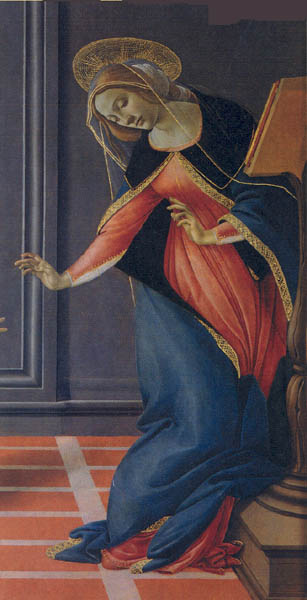
Imagine you are a medieval artist assigned to paint the Annunciation—the very moment when Mary first hears the news that she has been singled out by God to bear “the Son of the Most High,…the king over the House of Jacob for ever” (Luke 1:32–33). You must show Mary’s reaction as she humbly accepts this astonishing and auspicious mission. You must portray the angel Gabriel. You must represent God’s Spirit, and what is perhaps your most difficult task, you must illustrate the Spirit becoming flesh—that is, Mary being impregnated by the Holy Spirit. As if that weren’t enough, you must keep in mind the centuries-long theological discussion of this miraculous event, described only once in the New Testament, in the Gospel of Luke:
In the sixth month the angel Gabriel was sent from God to a town in Galilee called Nazareth, with a message for a girl betrothed to a man named Joseph…The girl’s name was Mary…
The angel went in and said to her, “Greetings, most favored one! The Lord is with you.” But she was deeply troubled by what he said and wondered what this greeting might mean.
Then the angel said to her, “Do not be afraid, Mary, for God has been gracious to you; you shall conceive and bear a son, and you shall give him the name Jesus. He will be great; he will bear the title, ‘Son of the Most High’”…
“How can this be?” said Mary: “I am still a virgin.” The angel answered, “The Holy Spirit will come upon you, and the power of the Most High will overshadow you; and for that reason the holy child to be born will be called ‘Son of God’”…
“Here am I,” said Mary; “I am the Lord’s servant; as you have spoken, so be it.”
(Luke 1:26–38)
Fortunately, as a medieval or Renaissance artist, you need not work from scratch. Artists in those days tended not to stray far from traditional renderings of any given particular subject, and with the Annunciation, they inherited a long, long line of images on which to draw, beginning with the earliest Annunciation scenes painted on catacomb walls and carved on sarcophagi.
Because of this, Annunciation scenes are almost always immediately recognizable. They typically show the Virgin approached and addressed by an angel bearing a staff or lily. Rays of light shine down on Mary and a dove flutters about her. In the West, Mary is usually shown indoors reading a book, undoubtedly a Bible, when the angel interrupts her; she thus appears to be faithful and devout. In the East, she is typically shown spinning wool.

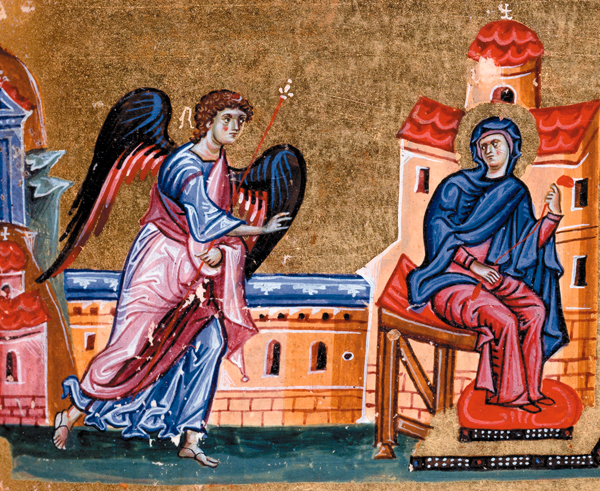
Despite their familiarity, none of these elements (beside the angel and Mary) appears in Luke. But they cannot be dismissed as decorative details either: Rather, they reflect the great theological issues surrounding this story. The challenge in church theology was to balance the reality of the divine incarnation with the perpetual purity and faith of Mary. The same was true of church art.
The church believed that original sin was passed on to every truly human being, beginning with Adam and Eve—“Adam knew Eve” (Genesis 4:1), in the act of conception (impregnation). Now, Jesus was “conceived by the Holy Spirit and born of the Virgin Mary”; in other words, he was a human being and the incarnation of the Word of God. How, then, was it possible for conception and birth not to pass along “original sin” in Mary’s case? It was only possible because Mary—alone of all women—was, according to church belief, without sin.
This theological balancing act begins in the Gospel of Luke itself. In response to Mary’s resounding question “How can this be?” the angel succinctly explains that the Holy Spirit will “overshadow” her (Luke 1:35). As Garry Wills puts it, “The New Testament is a book of theology, not of obstetrics or gynecology.”1
The term “overshadow” (Greek, episkiazein, skiazein) does not denote divine sexual activity; it cannot in any way be compared with the many stories of Greek and Roman gods having intercourse with humans and impregnating human women (for example, Zeus and Semele or Leda). Rather, in Jewish and Christian traditions, “overshadow” usually refers to the mysterious and protective presence of God in the Tabernacle or to other divine manifestations. In Psalm 91, we read, for example, “[The Lord] will overshadow you with his pinions; you will find refuge under his wings” (Psalm 91:2; see also Luke 9:34–5; Exodus 40:35; Numbers 9:18, 22).
Luke’s account uses the term “overshadow” to emphasize the miraculous character of the Virgin’s pregnancy; the term removes any sexual nuance. It thus stands in contrast to the gospel’s more explicit statement that Mary will “conceive in the womb” (Luke 1:31). One might ask, Where else? But the redundancy is necessary in order to give equal weight to the natural aspect of Jesus’ birth. The Son of God must be divine but must also be truly incarnate.
How are these theological concerns reflected in artistic depictions of the Annunciation?
Consider the image of the white dove, which descends on Mary in almost every Annunciation scene. Although the dove does not appear in Luke’s description of the Annunciation, it is nevertheless an almost universal symbol of the Holy Spirit in the early church. In the New Testament descriptions of Jesus’ baptism, the Holy Spirit is said to appear and descend “like a dove” (Mark 1:10; Matthew 3:16; John 1:32; Luke 3:22 is more concrete: “in bodily form like a dove”). In art, too, the dove is associated with the substance of the Holy Spirit; as early as the building of the famous church of Santa Maria Maggiore in Rome (c. 432), a mosaic Annunciation scene (not shown here) includes the Holy Spirit in the form of a dove. In art, the dove signifies that the Annunciation is the moment of Jesus’ conception. In fact, in the early church the Feast of the Annunciation was originally called the Feast of the Lord’s Conception—Conceptio Domini.
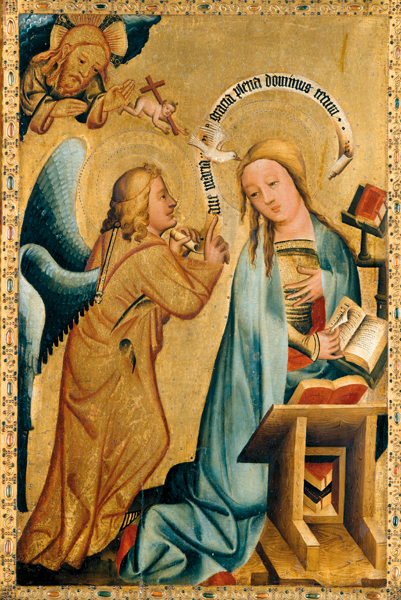
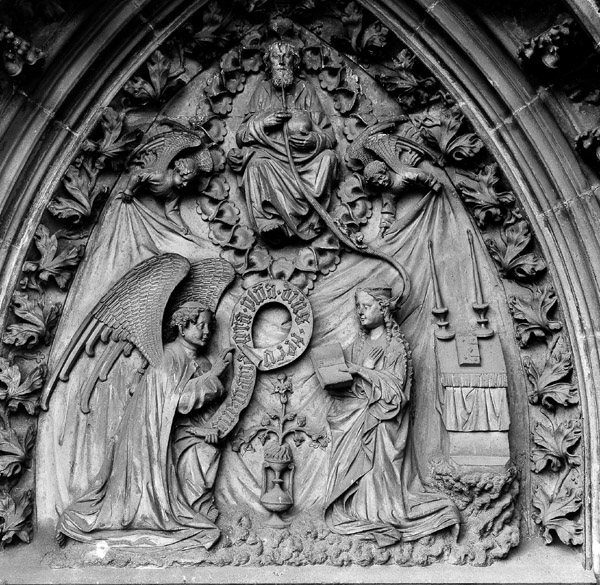
Luke’s spare narrative is the only gospel account of the Annunciation. There are, however, other early Christian texts that provide more detailed descriptions of the event and the setting. The most influential was the Infancy Gospel of James (in Latin, Protevangelium Jacobi), which dates from as early as the mid-second century.a James was the first of the so-called infancy gospels—extrabiblical accounts of the childhood of Mary, of her becoming the mother of Jesus, and then of Jesus’ own childhood. The infancy gospels fill in some of the details absent from the canonical gospel accounts. Most popular in the eastern church, the Gospel of James spawned early medieval (sixth to eighth century) spin-offs—the Gospel of Pseudo-Matthew and the Gospel of the Birth of Mary—that became standards in the West.
According to the Gospel of James, the Jerusalem priests summoned Mary along with several other virgins to the Temple to weave a new veil for the sanctuary. Each young woman is assigned a different color of thread to spin. Mary, having just begun to spin the purple thread, stops and makes a trip to the well:
And [Mary] took the pitcher and went out to draw water, and behold, a voice said, “Hail, highly favored one, the Lord is with you, you are blessed among women.” And she looked around to the right and to the left to see where this voice came from. And trembling, she went to her house and put down the pitcher and took the purple and sat down on her seat and drew out the thread. And behold, an angel of the Lord stood before her and said, “Do not fear, Mary; for you have found grace before the Lord of all things and shall conceive by means of his Word.” When she heard this she considered it and said, “Shall I conceive by the Lord, the living God and bear as every woman bears?” And the angel of the Lord said, “Not so, Mary; for the power of the Lord shall overshadow you…” And Mary said, “Behold, (I am) the handmaid of the Lord before him; be it to me according to your word.”
(Infancy Gospel of James 11:1–7, 9)2
Although medieval portrayals of the Annunciation usually set the event in Joseph’s house, in the earliest church art the event was often depicted outside, at a well. In the Infancy Gospel of James, the Annunciation takes place in two stages at these two settings. We thus may well have evidence of two Annunciation traditions in the early church: one at the well, the other in Joseph’s house. In church art, these events come together in two sumptuously illuminated 11th-century manuscript collections of sermons by the Byzantine monk James Kokkinobaphos, known as the Homilies of the Monk James—one in the Vatican Library (see photos of illuminations from 11th-century manuscript of sermons) the other in the Bibliothèque Nationale, Paris. Both depictions follow James’s account of the Annunciation closely, beginning outside at the well and concluding with Mary indoors spinning thread.
The other great contribution the Infancy Gospel of James made to the story—and to its subsequent depiction in art—is its answer to Mary’s question: “How can this be? I am still a virgin.” The Infancy Gospel of James answers this thorny question with a somewhat more explicit (though still mysterious) account of the conception than the one we find in Luke: “You shall conceive by means of his Word,” James’s angel informs Mary.
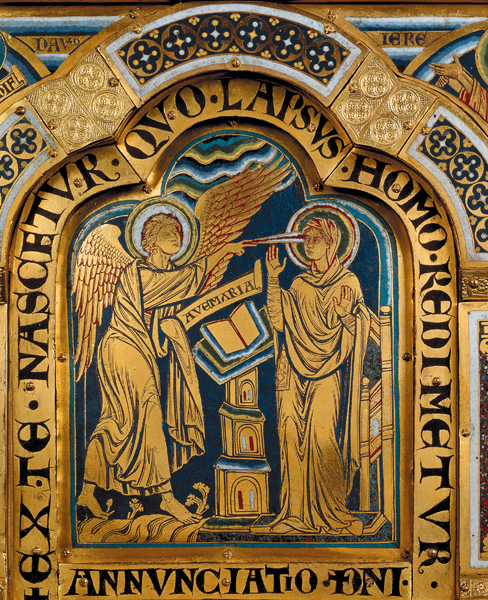
Although conception “by the Word” is never mentioned in the canonical Gospels, it is nevertheless a biblical concept: It is by the Word that God creates all reality (Genesis 1); and John’s gospel (among many other scriptural passages) emphasizes that the Word is the Holy Spirit become flesh. The same Word that created the world is the Word that “became flesh and tabernacled among us” (John 1:14).
For medieval artists, the concept of impregnation “by the Word” suggested a workable solution to the problem of creating a pure, nonlustful Annunciation scene. The Word is represented by showing Mary reading a book or scroll. That the book is usually open suggests her openness to the Word. In Robert Campin’s early-15th-century Annunciation, known as the Merode Altarpiece (see photo of Merode Altarpiece in “Lions, Lilies and Mousetraps”), the pages appear to be riffling, as if the Spirit and Word were passing through the book to Mary; the book thus becomes an active instrument of God’s conceiving and creating Word. In many Annunciations, the Bible is open to Isaiah 8:14 and the text is visible: “Behold, a virgin shall conceive and bear a son.”b In some cases a scrolling text bearing the angel’s words unfurls near her.
For some artists the open book and scroll were not explicit enough. Many art works offer much more graphic depictions of the Word entering Mary—sometimes in ways that may seem unusual to the modern viewer. For example, the impregnation of Mary by the Word is often pictured as taking place through her ear. It is common to see the dove, the rays of light or a scroll aim directly at the side of Mary’s head—which might seem less strange when we remember that, in the past, books were much more removed from the daily life of most people than they are today. Before the invention of the printing press, the vast majority of people were illiterate, so the narratives of the faith were passed down to the pew primarily by word of mouth, in sermons and liturgical dramas, as well as in art. Thus people wouldn’t have associated the Word with reading as much as with being read to.
In an Armenian version of the Infancy Gospel of James, the text says explicitly “and at the same time as he (that is, Gabriel) spoke the word and the holy virgin bowed down, the word of God entered into her ear of hearing within.” In the Middle Ages, conception through the Virgin’s ear was also expressed in several mystery plays and poems, including this 12th-century verse:
To you there came a child,
woman [Mary], through your ear.3
The most graphic visual presentation of conception per aurem appears in a relief (see photo above) over the door to the Marienkappelle (Church of Mary) in Würzburg, Germany. God sits enthroned over the angel and Mary. He holds to his mouth a hose-like tube that passes down to the Virgin’s ear. Sliding down the tube is a miniature baby Jesus and, at the end of the tube, entering Mary’s ear, a dove!
There were other ways an artwork could portray the impregnation of Mary “by means of the Word.” Some images interpret the conception by the Word as taking place through sight; the eyes are another means by which we can internalize the Word. On an enamel (see photo of enamel altar) by Nicholas of Verdun, dated to around 1180, the rays of the holy power move from the angel’s hand to the Virgin’s eyes. In other cases, such as a 14th-century painting by Master Bertram of Minden (see photo of 14th-century painting by Master Bertram of Minden), the Virgin’s impregnation by the Word is symbolized by the dove actually piercing her halo and going directly into the top of her head; thus her purity is pierced but not sullied by the conceptual Word of God (which also encircles her head in the form of a scroll).

A few images are more suggestive of an impregnation directly into the Virgin’s womb: In a 15th-century Annunciation by Fra Filippo Lippi in London’s National Gallery (see photos of Annunciation by Fra Filippo Lippi), the dove hovers down by Mary’s womb, sending rays of light from its beak into a tiny slit in her tunic.4
The conception by means of the Word was so strongly fixed in Annunciation traditions that we find them in Protestant works as well. A powerful pen and watercolor (1526) by Albrecht Dürer is one example (not shown here). The Virgin is quietly reading, contemplating the Word that has spoken to her through her book. Her quiet attitude stands in strong contrast to the dynamic figure of the angel, who thrusts a scroll toward Mary. In this way, the conception by the Word is made manifest.
An interesting yet short-lived type of Annunciation scene incorporates elements of the Infancy Gospel of James’s legacy with a theme that comes from mythology. In a tapestry (see photo, below) from around 1500, in Munich’s Bayerisches National Museum, the Virgin is seated in a walled garden, with a unicorn resting its head in her lap. The angel appears in the guise of a huntsman blowing his horn. God is seated in heaven above. From his mouth issue the Word, the baby Jesus, and a dove, which descend on rays of light toward the Virgin’s breast—that is, toward the seat of her piety and mercy. A well in the background reminds us of the Infancy Gospel of James. Tapestries came into fashion in Europe in the late 13th century. They often featured hunting scenes, including hunts of the mythical unicorn. The unicorn was a symbol of power and savagery: Just imagine the threat of a great stallion with a long, lance-like horn protruding from its forehead. With its single large horn, the unicorn was also a symbol of male potency: According to medieval folklore, the beast could be tamed only by a virgin. At some point, sculptors and painters began to depict the unicorn in the lap of the Virgin; the unicorn thus became a symbol of the incarnation. The images were frowned upon by the church, and in 1563 the Council of Trent prohibited unicorn Annunciations.

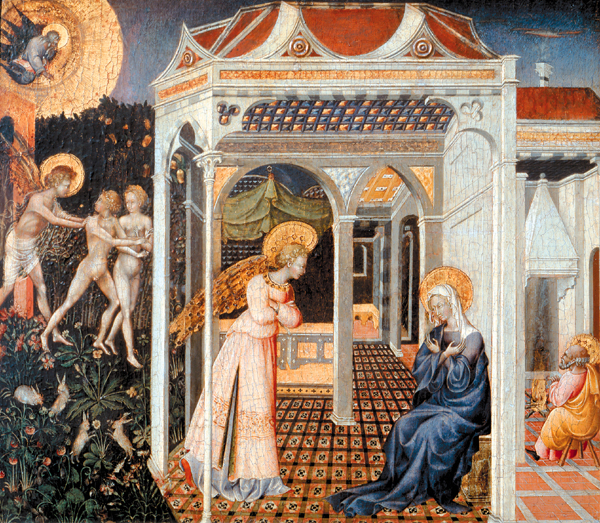
Another powerful reason for combining the Annunciation and unicorn scenes was the garden setting. An enclosed garden (hortus conclusus) is often visible in Annunciation scenes, either in the foreground (as in Filippo Lippi’s,) or beyond, visible through a window or doorway. The garden refers back to the very first garden, Eden.
For Christians, the moment of Jesus’ conception is the beginning of God’s mighty act of salvation; that is, it is a direct reversal of the disaster that took place in the Garden of Eden. In many Annunciations, the expulsion of Adam and Eve, depicted in the background, makes this relationship explicit, as in the mid-15th-century Annunciation (see photo above) by Giovanni di Paolo di Grazia, now in the National Gallery of Art in Washington, D.C. But an empty garden alone is enough to carry the meaning. The continued presence of the garden in Annunciation pictures says with images what was sung in an old English carol:
Nova, Nova
Ave fit ex Eva.News, news
Ave has been made from Eve.5
There are few Christians today (excepting, of course, diligent readers of BR) who have even heard of the Infancy Gospel of James, and yet the concepts expressed in that gospel, such as the conception through the Word, are well known—primarily because they have survived in the art of the church. For this, we must thank the creative artists who struggled to show us the answer to Mary’s poignant question, “How can this be?”
MLA Citation
Footnotes
See David R. Cartlidge, “The Christian Apocrypha: Preserved in Art,” BR 13:03; Cartlidge and J. Keith Elliott, Art and the Christian Apocrypha (New York: Routledge, 2001); and “The Favored One,” BR 17:03, by Ronald F. Hock with captions by David R. Cartlidge.
In the original Hebrew, Isaiah’s prophecy does not mention a “virgin.” But when the text was translated into Greek in the third century B.C., the Hebrew term almah (young woman) was replaced with Greek parthenos, which does mean virgin. See J. Edward Barrett, “Can Scholars Take the Virgin Birth Seriously?” BR 04:05.
Endnotes
For a translation of the infancy gospel, see J. Keith Elliott, The Apocryphal New Testament (Oxford: Clarendon Press, 1993).
For a different interpretation of this painting, see Leo Steinberg, “‘How Shall This Be?’ Reflections on Filippo Lippi’s Annunciation in London, Part I,” Artibus et Historiae 16 (1987), pp. 25–44.


